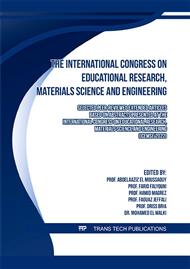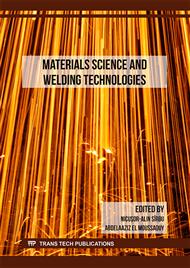[1]
D.-B. Xiong et al, « Enhanced thermoelectric figure of merit in p-type Ag-doped ZnSb nanostructured with Ag3Sb », Scripta Materialia, vol. 69, p.397‑400, 2013.
DOI: 10.1016/j.scriptamat.2013.05.029
Google Scholar
[2]
D. Liu et al, « Active low-grade energy recovery potential for building energy conservation », Renewable and Sustainable Energy Reviews, vol. 14, p.2736‑2747, 2010.
DOI: 10.1016/j.rser.2010.06.005
Google Scholar
[3]
R. Funahashi et al, « A portable thermoelectric-power-generating module composed of oxide devices ». American Institute of Physics, 2006.
Google Scholar
[4]
C. Uher et al, « Transport properties of pure and doped MNiSn (M= Zr, Hf) », Physical Review B, vol. 59 , p.8615, 1999.
Google Scholar
[5]
W. Xie et al, « Recent advances in nanostructured thermoelectric half-Heusler compounds », Nanomaterials, vol. 2, p.379‑412, 2012.
DOI: 10.3390/nano2040379
Google Scholar
[6]
S. Chen et al « Recent progress of half-Heusler for moderate temperature thermoelectric applications », Materials today, vol. 16 , p.387‑395, 2013.
DOI: 10.1016/j.mattod.2013.09.015
Google Scholar
[7]
C. Okamura et al, « Preparation of single-phase ZnSb thermoelectric materials using a mechanical grinding process », Materials transactions, vol. 51, p.860‑862, 2010.
DOI: 10.2320/matertrans.mh200902
Google Scholar
[8]
S. Saadat et al., « Template-free electrochemical deposition of interconnected ZnSb nanoflakes for li-ion battery anodes », Chemistry of Materials, vol. 23, p.1032‑1038, 2011.
DOI: 10.1021/cm103068v
Google Scholar
[9]
C.-M. Park et al, « Quasi-Intercalation and Facile Amorphization in Layered ZnSb for Li-Ion Batteries », Advanced materials, vol. 22 , p.47‑52, 2010.
DOI: 10.1002/adma.200901427
Google Scholar
[10]
L. Bjerg et al, « Modeling the thermal conductivities of the zinc antimonides ZnSb and Zn4Sb3 », Physical Review B, vol. 89, no 2, p.024304, 2014.
Google Scholar
[11]
L. Bjerg, et al, « Ab initio calculations of intrinsic point defects in ZnSb », Chemistry of Materials, vol. 24, p.2111‑2116, 2012.
DOI: 10.1021/cm300642t
Google Scholar
[12]
A. Bafekry et al., « Surface functionalization of the honeycomb structure of zinc antimonide (ZnSb) monolayer: A first-Principles study », Surface Science, vol. 707, p.121796, 2021.
DOI: 10.1016/j.susc.2020.121796
Google Scholar
[13]
A. Bafekry et al, « Electro-optical and mechanical properties of Zinc antimonide (ZnSb) monolayer and bilayer: A first-principles study », Applied Surface Science, vol. 540, p.148289, 2021.
DOI: 10.1016/j.apsusc.2020.148289
Google Scholar
[14]
S. Malki et al, « Structural and electronic properties of zinc antimonide ZnSb », Materials Today: Proceedings, vol. 31, p. S41‑S44, 2020.
DOI: 10.1016/j.matpr.2020.05.598
Google Scholar
[15]
S. Malki et al, « A First-Principles Investigation on Electronic Structure and Optical Properties of Tetragonal Iron Antimonide FeSb2 », Journal of Superconductivity and Novel Magnetism, p.1‑10, 2022.
DOI: 10.1007/s10948-022-06201-z
Google Scholar
[16]
X. Song et al, « Review of research on the thermoelectric material ZnSb », Thermoelectrics for Power Generation: A Look at Trends in the Technology, 2016.
DOI: 10.5772/65661
Google Scholar
[17]
K. Niedziolka et al, « Influence of the Exchange–Correlation Functional on the Electronic Properties of ZnSb as a Promising Thermoelectric Material », Journal of Electronic Materials, vol. 44, p.1540‑1546, 2015.
DOI: 10.1007/s11664-014-3459-9
Google Scholar
[18]
G.-L. Zhao et al, « Reliable density functional calculations for the electronic structure of thermoelectric material ZnSb », AIP Advances, vol. 8, p.105211, 2018.
DOI: 10.1063/1.5051346
Google Scholar
[19]
A. Berche et al, « Thermoelectric power factor of pure and doped ZnSb via DFT based defect calculations », Physical Chemistry Chemical Physics, vol. 21, p.23056‑23064, 2019.
DOI: 10.1039/c9cp04397g
Google Scholar
[20]
E. Sjöstedt et al, « An alternative way of linearizing the augmented plane-wave method », Solid state communications, vol. 114, p.15‑20, 2000.
DOI: 10.1016/s0038-1098(99)00577-3
Google Scholar
[21]
P. Blaha et al, « wien2k », An augmented plane wave+ local orbitals program for calculating crystal properties, vol. 60, 2001.
Google Scholar
[22]
W. Kohn et al, « Self-consistent equations including exchange and correlation effects », Physical review, vol. 140, p. A1133, 1965.
DOI: 10.1103/physrev.140.a1133
Google Scholar
[23]
J. P. Perdew et al, « Generalized gradient approximation made simple », Physical review letters, vol. 77, p.3865, 1996.
DOI: 10.1103/physrevlett.77.3865
Google Scholar
[24]
F. Tran et al, « Accurate band gaps of semiconductors and insulators with a semilocal exchange-correlation potential », Physical review letters, vol. 102, p.226401, 2009.
DOI: 10.1103/physrevlett.102.226401
Google Scholar
[25]
M. Yeganeh et al, « Thermoelectric properties of InN graphene-like nanosheet: a first principle study », Superlattices and Microstructures, vol. 138, p.106367, 2020.
DOI: 10.1016/j.spmi.2019.106367
Google Scholar
[26]
G. K. Madsen et al, « BoltzTraP. A code for calculating band-structure dependent quantities », Computer Physics Communications, vol. 175, p.67‑71, 2006.
DOI: 10.1016/j.cpc.2006.03.007
Google Scholar
[27]
P. B. Allen et al, « Anisotropic normal-state transport properties predicted and analyzed for high-Tc oxide superconductors », Physical Review B, vol. 37, no 13, p.7482, 1988.
Google Scholar
[28]
M. Manzoor et al., « First-principles calculations to investigate structural, dynamical, thermodynamic and thermoelectric properties of CdYF3 perovskite », Computational and Theoretical Chemistry, vol. 1217, p.113928, 2022.
DOI: 10.1016/j.comptc.2022.113928
Google Scholar
[29]
C. Wood, « Materials for thermoelectric energy conversion », Reports on progress in physics, vol. 51, p.459, 1988.
Google Scholar
[30]
J. Zheng, « Recent advances on thermoelectric materials », Front. Phys. China, vol. 3, p.269‑279, 2008.
Google Scholar
[31]
E. Haque et al, « Elastic, magnetic, transport and electronic properties of noncentrosymmetric M2Mo3N (M= Fe, Co, Ni, Rh): A first-principles study », Journal of Alloys and Compounds, vol. 748, p.117‑126, 2018.
DOI: 10.1016/j.jallcom.2018.03.151
Google Scholar
[32]
M. Boudjelal et al., « Structural, magnetic, and optoelectronic properties of new ferromagnetic semiconductors Cd0.75Os0.25S and Cd0. 75Ir0. 25S: Insight from DFT computations », Optical and Quantum Electronics, vol. 54, p.1‑23, 2022.
DOI: 10.1007/s11082-022-04073-0
Google Scholar
[33]
F. Weber et al., « Low-temperature properties and magnetic order of Eu Zn2Sb2 », Physical Review B, vol. 73, no 1, p.014427, 2006.
Google Scholar



